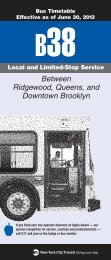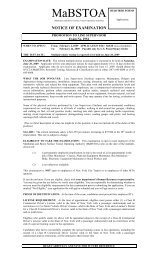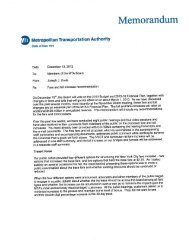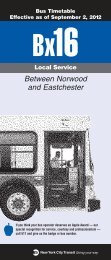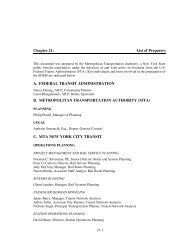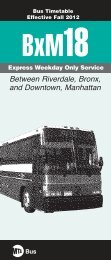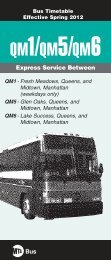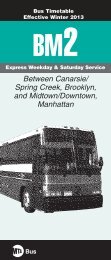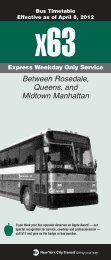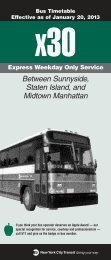Greening Mass Transit & Metro Regions: The Final Report - MTA
Greening Mass Transit & Metro Regions: The Final Report - MTA
Greening Mass Transit & Metro Regions: The Final Report - MTA
Create successful ePaper yourself
Turn your PDF publications into a flip-book with our unique Google optimized e-Paper software.
54<br />
Groundwater: From Old Nuisance to New Resource<br />
Like many subway systems, the <strong>MTA</strong> spends energy pumping<br />
groundwater out of tunnels, up to 8 million gallons per<br />
day on dry days. Once a nuisance, this water should be<br />
regarded as a valuable resource for thermal-exchange cooling<br />
and heating, washing vehicles and other non-potable uses.<br />
Typical Subway Drainage and Pumping System<br />
Rainwater Collection at Corona<br />
A rainwater collection system on the roof of the Corona<br />
Maintenance Shop in Queens drains rainwater into a<br />
40,000-gallon underground storage tank that supplies water<br />
to a subway car wash. Approximately 80 percent of the<br />
wash water is then collected as greywater and recycled, with<br />
potable water used only for the final rinse.<br />
<strong>MTA</strong> Impacts Wetlands and Vice Versa<br />
Wetlands filter pollution found in stormwater, serve as groundwater<br />
recharge zones, protect land from coastal<br />
erosions and against storm surges, and provide habitat for<br />
wildlife. <strong>The</strong>se benefits, if lost, are extremely costly to recreate.<br />
With many rights-of-way along wetlands, the <strong>MTA</strong> and its<br />
partners have a responsibility to protect and rehabilitate wetlands.<br />
Since wetlands buffer sea surges, the <strong>MTA</strong> also has a<br />
vested interest in such protection. In its systemwide sustainability<br />
planning, the <strong>MTA</strong> should include the value of wetlands,<br />
especially in relation to climate change impacts on the coastal<br />
environment. Dying wetlands in and around the city and<br />
Jamaica Bay could hasten erosion, disrupt wild bird flyways,<br />
and decrease land buffers to storm surges, which in turn<br />
threaten the <strong>MTA</strong>’s operations and long-term sustainability.<br />
NEAR-TERM RECOMMENDATIONS<br />
Recommendation 1. Implement Systemwide Metering and<br />
Submetering<br />
<strong>The</strong> <strong>MTA</strong> should install additional water meters to develop an accurate<br />
database covering various categories of water use, including washing<br />
buses, washing rolling stock, parts washing, employee usage, and transformer<br />
cooling. Metering would measure and track usage and would be<br />
useful in developing effective conservation strategies. It would be helpful<br />
in evaluating and monitoring effectiveness of new technologies installed.<br />
<strong>The</strong> introduction of metering should proceed in the following phases:<br />
• Phase One. Begin data collection on all major water demands using<br />
metering and submetering, supported by detailed estimates based on<br />
numbers of vehicles, pump capacities, and other data, as stated in the<br />
Commission’s Interim <strong>Report</strong>. This would include a leak-detection program.<br />
• Phase Two. Evaluate data to identify cost-efficient options for reducing<br />
water use. Collect supporting information, including the proximity and quality<br />
of alternative water sources and capital projects. Based on these analyses,<br />
set water reduction targets.<br />
• Phase Three. Prioritize and implement a schedule for achieving targets,<br />
beginning with the most affordable and least disruptive steps. In addition,<br />
the <strong>MTA</strong> should assess the value of joining the DEP automatic meter<br />
reading initiative.<br />
Recommendation 2. Improve the Efficiency of Vehicle Washes<br />
Washing vehicles represents about a fifth to a third of the <strong>MTA</strong>’s water<br />
use. <strong>MTA</strong> agencies should make greater use of stormwater, as is already<br />
done at the Corona Maintenance Shop. <strong>The</strong> <strong>MTA</strong> should consider the<br />
following steps for wash facilities and operations:<br />
• Minimizing wash cycles and detergents, reducing wash frequency,<br />
cutting the amount of rinse water, shorter wash cycles, lower pump<br />
capacities, and using alternative water sources.<br />
• Using advanced wash water treatments, such as: automated bus<br />
washing, water quality sensors and automation, multimedia filters,<br />
and chemical coagulants.<br />
• Using nonpotable water, such as treated groundwater to wash buses.<br />
Recommendation 3. Improve Stormwater Control and Reduce<br />
Stormwater Runoff<br />
Uncontrolled runoff from storms can overwhelm sewer systems, causing<br />
Combined Sewer Overflows (CSOs) and polluting waterways. Climate<br />
change is likely to exacerbate these problems, as discussed in the Climate<br />
Adaptation chapter of this report. In response, the Commission recommends<br />
that the <strong>MTA</strong> improve management of stormwater on <strong>MTA</strong> roofed<br />
facilities, parking lots, and other non-permeable properties, targeting a<br />
25 to 50 percent reduction in storm runoff by 2020. <strong>The</strong> Commission<br />
recommends the following steps.



